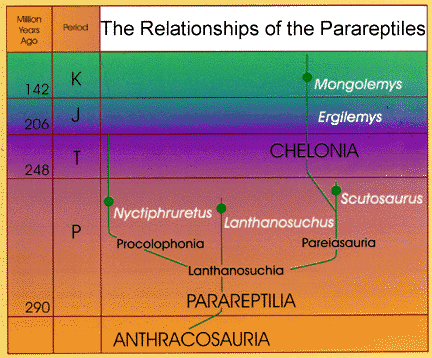
Figure:
The phylogeny of the parareptiles.
Known from the Late Devonian to the Early
Triassic,
the Anthracosauria probably had a very short amphibian stage of their
evolution
and gave rise appearently to all groups of reptiles.
In the Middle
Carboniferous the reptilian descendants of anthracosaurs left the water,
took
over the land and gradually ousted amphibians from the
land communities,
so most amphibians have become freshwater
inhabitants since the Late Permian.
The success of reptiles was largely due to
reproduction by means of dense-shelled eggs.
In fact, every egg is a very complete
"individual basin" protected by the shell,
where the developing organism
can become a small likeness of the adult without
going through the intermediate
stage of a freely living larva.
Reptiles also developed dense scaled skin to protect
the body against drying in the air,
and more effective lung functions, usually
provided by the mobility of the ribs.
The process of evolution from amphibians
into reptiles, like a transformation from
lobe-finned fishes into amphibians,
could also occur more than once.
The principal descendent groups of anthracosaurus
are parareptiles (which include
modern turtles along with diverse fossil forms),
diapsids (which include, on the one hand,
dinosaurs, pterosaurs,
crocodiles, and birds, and on the other hand, lizards and snakes),
and synapsids
(among them mammal-like reptiles that gave rise to mammals).
Some primitive representatives
of the parareptiles retained many amphibian features,
including soft glandular
skin. The parareptiles like their ancestors, the anthracosaurs,
possessed the
a skull without openings for jaw muscles, that allows to assign them to
anapsids.
This group name means it arch-less". Fossil remains of the diverse parareptiles
are
especially abundant in the Late Permian of East Europe. In the "Russian
Dinosaur
Exposition", they are represented by relatively small lizard-like
Nyctiphruretus,
extraordinarily flattened Lanthanosuchus
and huge aquatic Scutosaurus.
The turtles, appeared
at the end of the Triassic Period and still exist today.
They are a peak of evolution
in the parareptiles. All ground turtles are easily
recognizable by their bony
shell. The shell is a protection against enemies.
It also provides, like a thermos,
rather stable conditions for the organism.
The turtle shells in the exhibit are
the Late Cretaceous Mongoleus and Late Eocene
Ergilemys,
both come from southern Mongolia. They look like quite
modern, although
they are dated to approximately 74 and 35 million years before
present, respectively.
In the primitive parareptiles, breathing was accomplished
by the movement of wide neck
ribs. A low level of metabolism has allowed turtles
to abandon even this mechanism for
filling the lungs. Instead, movement of their
neck and legs changes a space inside of the
rigid shell, that creates some vacuum
to fill the lungs with air.




